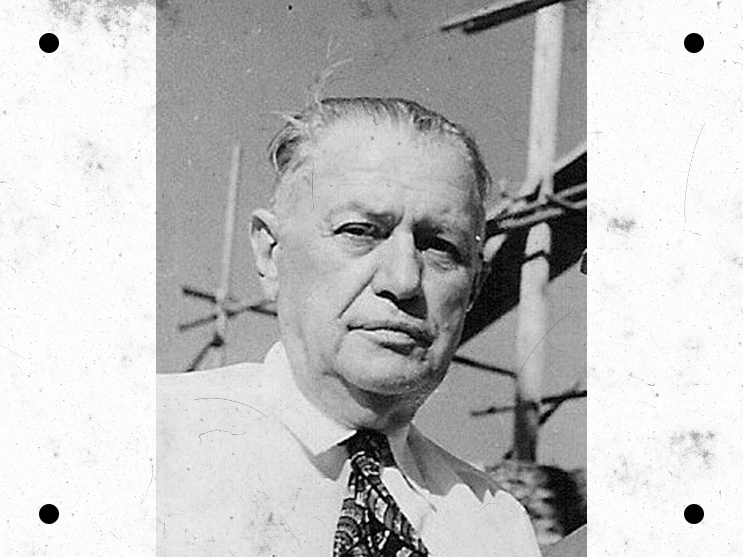George B. (Weitzel) Quatman was born to immigrant parents from Alsace-Lorraine. He was raised from a young age by his mother in Sidney, Ohio.
Mrs. Weitzel was a faithful Catholic member of the Holy Angels Parish in Sidney. She became critically ill. Just before her death, she asked the parish priest Fr. Francis M. Quatman to watch over her eighteen month old son, George. The priest gave his word to Sophia he would do so.
Father Quatman adopted George and gave him the best education and upbringing he could. George always sought to honor the priest who raised him. With his strong Christian background, George was a devout Catholic his entire life.
He became a successful businessman in the telephone industry. George worked at the Sidney Telephone Company during school vacations from 1911-1913. His first job was with Western Electric in Illinois. Quatman returned to Sidney in 1916 as wire chief for Sidney Telephone Company. A promotion to manager quickly followed in 1918. He formed the Ohio Telephone Service company in 1924. It provided service to local areas such as Botkins, Jackson Center, Greenville and Sidney.
Quatman organized the Telephone Service Company of Ohio two years later. His leadership skills resulted in him forming four other businesses, all of which prospered.
He was a president of, then an active member of the board of directors of the Ohio Independent Telephone Association for many years.
Quatman was also a brilliant engineer. Innovation was real strength for him, He was awarded numerous patents, including the following:
• Automatic toll ticketing device to use with cordless boards
• First push button device permitting intercity dialing
• The first circuit in Ohio for voice-space communications through Telstar
• The first automatic and registering metering units
An event unrelated to his expanding business career changed the trajectory of his life.
In 1954, when a 5-year old grandson was paralyzed with polio, Mr. Quatman made a pilgrimage to several Marian shrines in Europe to pray for a healing. Upon his return, the grandson was healed. In thanksgiving, Quatman made another trip to Ephesus, Turkey, in 1955 to see the location he had heard of where the Blessed Virgin Mary had lived her final days on earth. He found the ruins of the Basilica of St. John which contained the tomb of the beloved disciple John, as well as the ruins of the Church of Mary – site of the 431 A.D. Council of Ephesus. It was when he found the partially restored ruins of the House of Mary, believed to have been built by St. John for Jesus’ mother after her departure from Jerusalem, that Mr. Quatman felt a calling to do something to preserve and restore these sacred sites.
It was reported that after his visit to Ephesus, Mr. Quatman had a remarkable vision in the skies as he stood on his hotel balcony in Izmir, looking to the sky and pondering all the ruins of sacred Christian sites that day. Fr. Bernard Deutsch wrote in 1965 that: “Our Lady appeared in the heavens over the valley of Ephesus and showed the Quatmans a vision first of the hilltop laid out in rows of lighted walks and gardens around St. John’s Basilica, then of her own restored Cathedral and finally of her home in the adjacent mountains. The vision was interpreted by its benefactor as an indication of the manner in which Mary desired the expression of gratitude to be planned.”
After research and consultation with spiritual and legal advisors, Mr. Quatman founded The American Society of Ephesus (ASE) in October 1955. He signed a treaty (protocol) with the Turkish government in 1958 which permitted the foundation to restore Christian sites in this Muslim country, and ASE began work on restoring St. John’s Basilica, the Church of Mary and the House of Mary. That work has continued for 60 years, through the efforts of Mr. Quatman’s sons, and now future generations of the Quatman family and other trustees of the private foundation.
In the 1970s, the people of Selcuk, Turkey named the public square in front of St. John’s Basilica “George B. Quatman Square,” to honor the efforts of this great man. In 2015, ASE gave a gift to the town of Selcuk to commemorate the 60th anniversary of the founding of The American Society of Ephesus. The new clock tower in the city center depicts the history of Ephesus and Selcuk, from its ancient pagan roots, to the Christian era and today’s Muslim culture.
Mr. Quatman and his foundation also funded a number of statues of the Virgin Mary around the world, including those on Indian Lake and at Lehman Catholic High School in Sidney.
